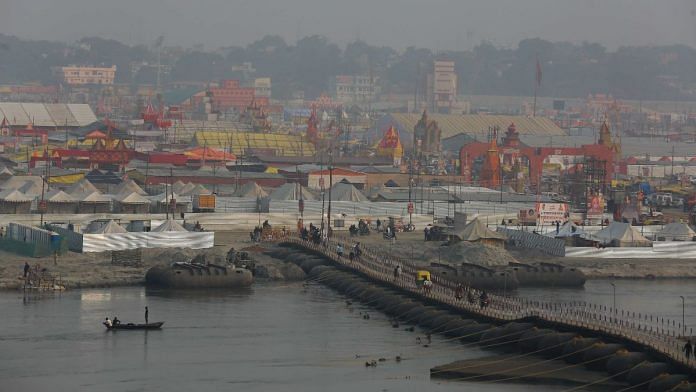Prayagraj: At the temporary office of the Prayagraj Mela Authority, Sub-Divisional Magistrate Sanjeev Kumar Ojha’s cabin is bustling with sadhus, vendors and people seeking accommodation. Ojha, the mela in-charge for the day, is directly involved in addressing the grievances of those who have begun gathering in the city for the Maha Kumbh.
“I am calling the respective official. You will get water in your sector,” Ojha says, while signing a document, responding to a sadhu who has travelled from Lucknow.
This temporary Mela authority office doubles as Prayagraj’s new Mela grievance cell, with a different officer on duty each day to resolve public complaints.
With the Maha Kumbh just days away, the Prayagraj Mela Authority is racing against time to ensure everything is in place. However, some roads are yet to be covered with checker plates and water facilities are left to be set up in a few areas.
The authorities are pulling out all the stops to meet the deadline—even if it means working extra hours and hiring additional labourers.
“We have established a city in three months. It’s not a small deal,” says a senior official.
On one side, police are escorting processions of sadhus—on camels, elephants and foot—to their respective akharas. On the other, labourers are toiling tirelessly to ensure that the site is ready in time. While some are covering the bare walls and tin sheds with posters of Maha Kumbh, others are setting up the tents.

Over 30,000 workers have been deployed from Bihar, West Bengal and Odisha, said an official. Massive temporary entry gates, with banners featuring photos of Chief Minister Yogi Adityanath and Prime Minister Narendra Modi, have been installed. Several cut-outs of Yogi and Modi can be spotted across the site of the mela.
The sprawling 4,000-hectare site has been divided into four zones and 32 sectors to ensure seamless delivery of services.
From 1.5 lakh toilets and 56 police stations to accommodation for 25,000 people, the Kumbh Mela authorities are trying hard to make the event a grand success. The chief minister is personally invested in the arrangements.
On Thursday, CM Yogi visited various akharas for inspection. “For people arriving in cars to take a dip, we have arranged for over 500 shuttle buses and more than 300 electric buses,” he said, highlighting the infrastructural provisions at the event.
The mela area is dotted with QR codes, in line with Yogi government’s digital push. Devotees are being asked to download the Kumbh app on their phones. For the first time, a cyber team has been deployed at the mela.

Additionally, 5,000 acres of land have been earmarked for parking, with the capacity to accommodate nearly 6 lakh cars. Each sector has been equipped with one hospital to ensure that medical emergencies are handled promptly.
Toilets have been organised into blocks, with ten toilets forming one block, each guarded by an assigned caretaker.
“We have implemented a seven-layer security system. Traffic police, water police, and fire tenders are on high alert,” a senior official says.
Sources within the administration say that officials are under immense pressure to prevent any stampede-like situation. Drones will be deployed for surveillance to ensure crowd control and safety.
“We’ve hardly slept in the last 15 days and are waiting with bated breath for the Kumbh to begin on a successful note,” says an official.
Also Read: Lost in Maha Kumbh? AI will find you with hi-tech ‘Bhule-Bhatke Kendras’






